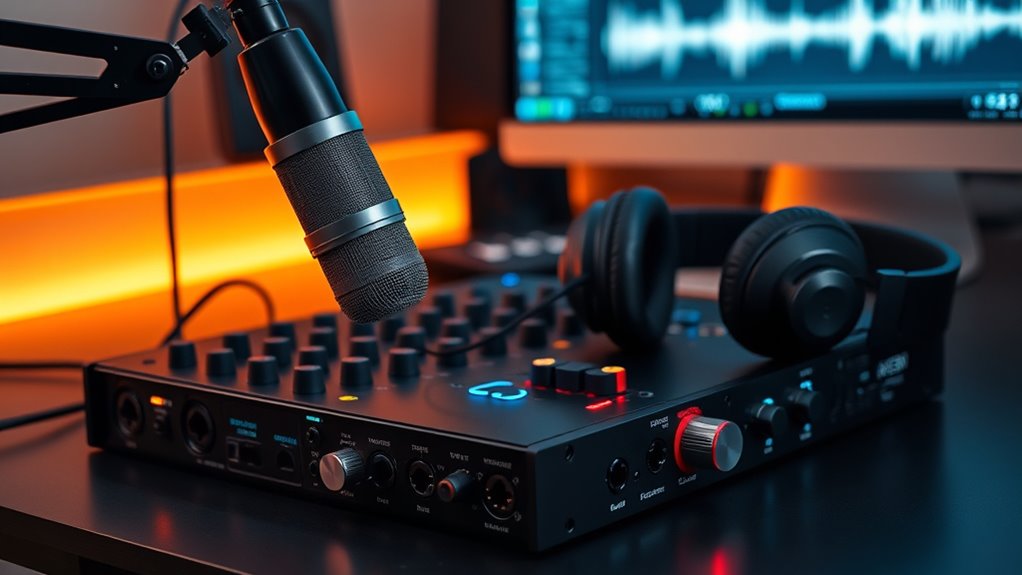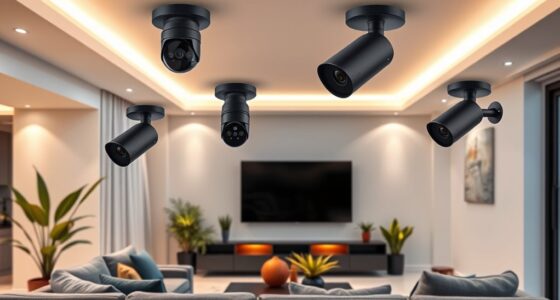If you’re looking for the best audio interfaces for podcasting in 2025, I recommend options with high-resolution support, low noise preamps, and versatile connectivity like USB-C and Thunderbolt. Devices like Focusrite Scarlett and MAONO offer great quality, portability, and user-friendly features. Whether you’re a beginner or a pro, choosing the right interface makes a big difference in sound clarity and ease of use. Keep exploring to find the perfect match for your setup and elevate your podcasting game.
Key Takeaways
- High-resolution support (24-bit/192kHz) ensures detailed, professional-grade audio quality for podcasters.
- Compatibility with popular devices and DAWs facilitates seamless setup across PCs, Macs, and mobile devices.
- Built-in preamps and effects enhance sound clarity, reduce noise, and allow real-time monitoring during recording.
- Compact, portable designs enable on-the-go recording and streaming for content creators and podcasters.
- Features like phantom power, multiple input types, and wireless streaming improve versatility for various recording needs.
MAONO USB Audio Interface for PC
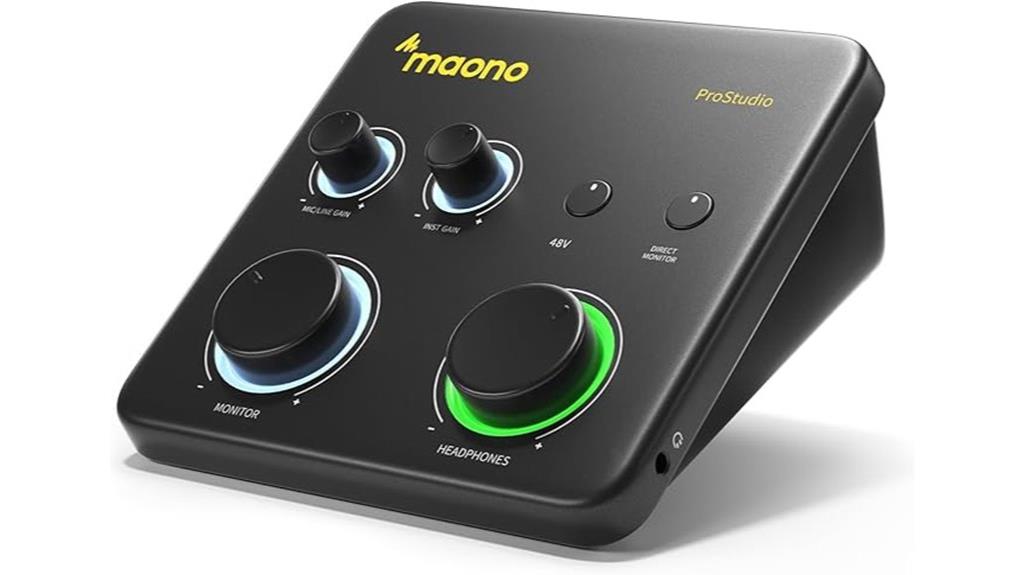
If you’re looking for an affordable yet professional-grade audio interface for podcasting, the MAONO USB Audio Interface for PC is a top choice. It offers high-resolution recording at 24-bit/192kHz with a dynamic range of 106dB, ensuring clear, realistic sound. It handles condenser and dynamic mics with up to 56dB preamp gain and phantom power, perfect for voice-overs and vocals. Its compact design is easy to use, with intuitive controls and compatibility across multiple devices, including Mac, Windows, iOS, and Android. Built with quality components, it delivers reliable, studio-quality sound, making it ideal for both beginners and experienced podcasters.
Best For: content creators, podcasters, and home studio enthusiasts seeking an affordable, professional-grade audio interface with versatile device compatibility.
Pros:
- High-resolution recording at 24-bit/192kHz ensures clear, detailed sound.
- Compact, user-friendly design with intuitive controls suitable for beginners and pros alike.
- Supports multiple devices including Mac, Windows, iOS, and Android for versatile use.
Cons:
- Occasional driver conflicts may cause crackling or popping noises initially.
- Limited built-in effects; users need DAW plugins for sound effects.
- Slightly basic build quality; some users desire more premium materials and additional features like ADAT ports.
SINWE Podcast Equipment Bundle with Microphone and Audio Interface
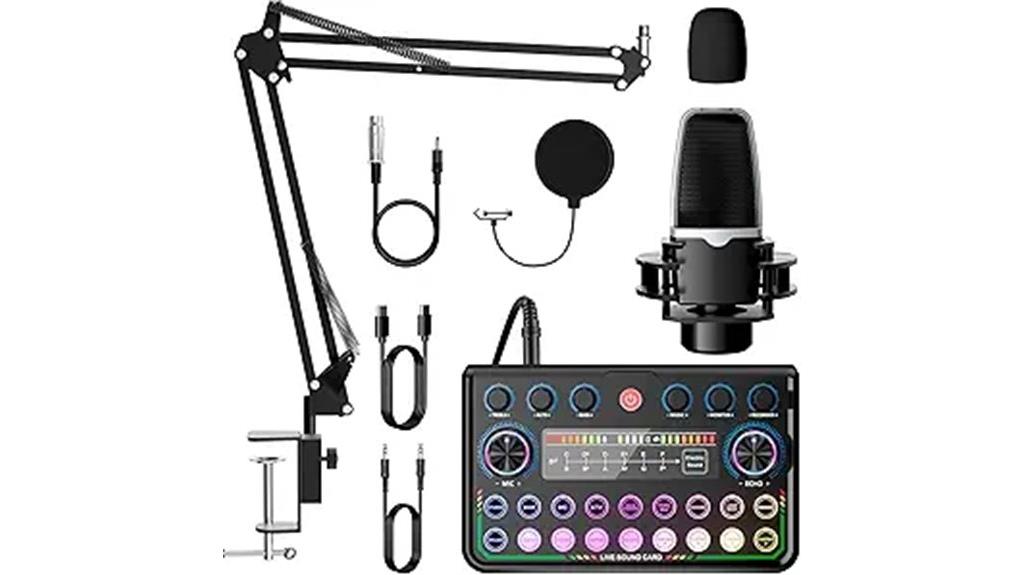
The SINWE Podcast Equipment Bundle with Microphone and Audio Interface is an excellent choice for content creators who want a versatile, all-in-one solution. It combines a high-quality USB condenser microphone with an audio interface and mixer, making it perfect for podcasting, streaming, singing, or gaming. The plug-and-play setup supports multiple devices and platforms without the need for phantom power, simplifying the process. With advanced sound effects, voice modulation, and clear, rich audio capture, this bundle enhances your content effortlessly. Its compatibility with popular software like OBS, Discord, and YouTube, along with dedicated support, makes it a reliable, user-friendly option for creators at any level.
Best For: content creators, podcasters, streamers, and musicians seeking a comprehensive, easy-to-use audio solution for recording and live streaming across multiple platforms.
Pros:
- All-in-one bundle combining microphone, audio interface, and mixer for versatile use.
- Plug-and-play setup compatible with various devices and platforms without needing phantom power.
- Advanced sound effects, voice modulation, and high-quality audio capture enhance creative possibilities.
Cons:
- May require additional accessories or software for advanced editing or streaming setups.
- Limited to USB connectivity; not suitable for professional XLR microphone setups.
- Some users might find the array of features overwhelming if seeking a simple microphone only.
MW-6 6 Channel DJ Audio Mixer
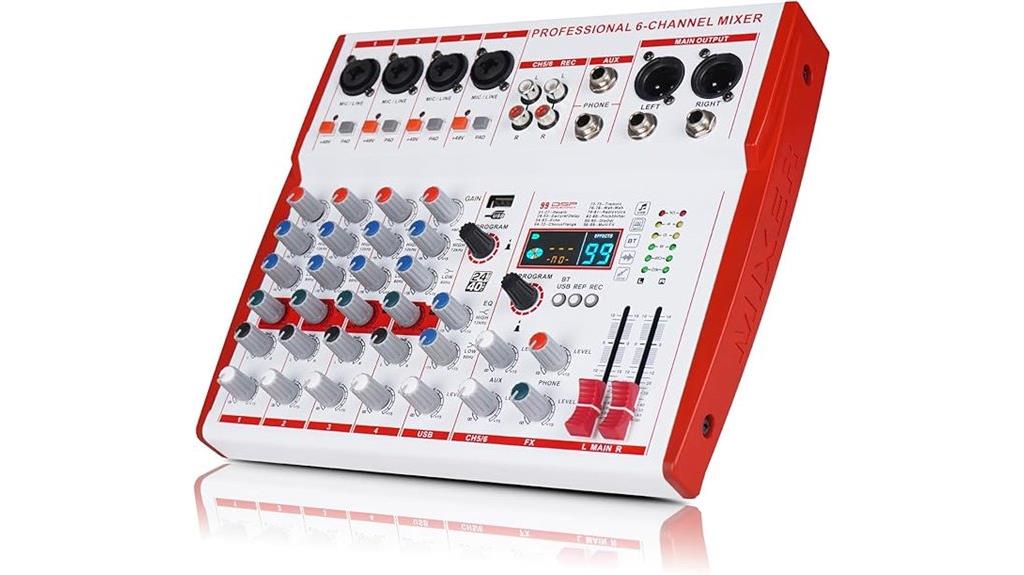
For podcasters seeking an affordable and versatile audio mixer, the MW-6 6 Channel DJ Audio Mixer stands out with its built-in 99 reverb effects and USB sound card. Its compact, lightweight design makes setup easy, whether you’re at home or on the go. With six channels, it handles multiple sources, including microphones, phones, and tablets, delivering clear, stable sound thanks to filtering AC interference. The built-in digital echo and reverb effects add professional flair to recordings, while the USB interface allows seamless connection for recording and playback. Rated highly for value and ease of use, it’s an excellent choice for those starting out or running small productions.
Best For: podcasters, small live streamers, and family event organizers seeking an affordable, versatile, and easy-to-use audio mixer with professional effects.
Pros:
- Compact, lightweight design for portability and quick setup
- Built-in 99 digital reverb and echo effects for enhanced sound quality
- Multiple input options including USB, Bluetooth, and external devices for versatile connectivity
Cons:
- Some users may experience initial difficulty adjusting reverb levels
- Potential voltage compatibility issues (110V vs. 220V) in different regions
- Instructions for use could be clearer to assist beginners with setup
Rockville R-TRACK SOLO USB C Audio Interface
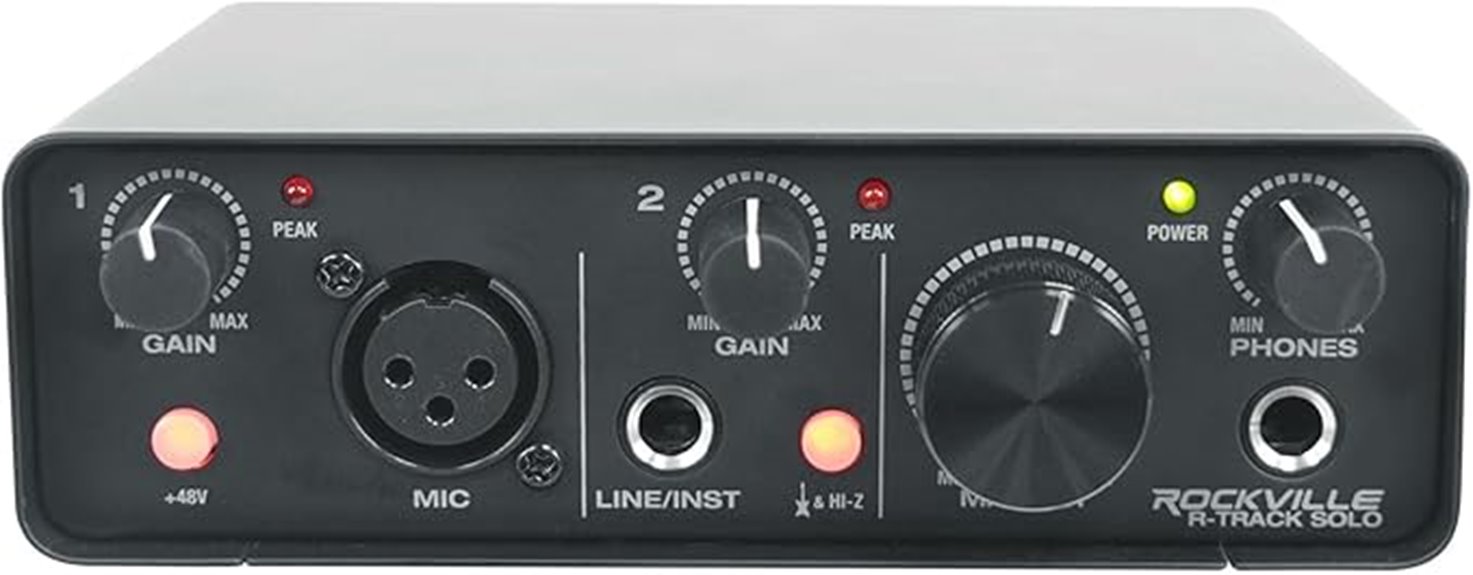
The Rockville R-TRACK SOLO USB C Audio Interface stands out for podcasters who need professional-quality sound without complicated setup. Its 24-bit/192kHz resolution captures clear vocals, instruments, and podcasts with studio-grade detail. The ultra-low latency ASIO drivers guarantee seamless recording, compatible with major DAWs like Pro Tools and Ableton. With a USB-C connection, it offers quick, plug-and-play ease for laptops and desktops. Plus, the 48V phantom power supports condenser mics, delivering clean, accurate vocals. Its compact, lightweight design makes it perfect for both home studios and mobile recording setups, making high-quality audio accessible and simple.
Best For: podcasters, home studio musicians, and content creators seeking professional-quality sound with simple, portable setup.
Pros:
- High-resolution 24-bit/192kHz audio for clear, detailed recordings
- Ultra-low latency ASIO drivers for seamless, real-time monitoring
- Compact, lightweight design ideal for mobile use and easy transport
Cons:
- Limited to USB-C connectivity, may require adapters for older devices
- No built-in microphone preamp or additional I/O options
- May be less suitable for large-scale studio setups requiring multiple inputs
Focusrite Scarlett Solo 3rd Gen USB Audio Interface

If you’re looking for a compact, high-quality audio interface that’s perfect for podcasting on the go, the Focusrite Scarlett Solo 3rd Gen stands out. It’s lightweight, durable, and connects directly via USB-C, making setup quick and easy. With 24-bit/192kHz converters and a single upgraded Scarlett mic preamp with Air mode, it delivers professional sound clarity. The high-headroom instrument input guarantees distortion-free recordings of guitars or bass. Its Gain Halo metering makes adjusting levels simple, while balanced outputs provide noise-free monitoring. Plus, it comes with a robust software bundle, making it ideal for podcasters seeking portability and studio-quality audio in one package.
Best For: podcasters, singer-songwriters, and portable recording enthusiasts seeking high-quality, compact audio interfaces for on-the-go production.
Pros:
- Compact, lightweight design for portability and easy setup
- Professional-grade 24-bit/192kHz audio quality with Air mode for enhanced clarity
- Versatile input options including high-headroom instrument input and combo microphone input
Cons:
- Limited to a single microphone/instrument input, less suitable for multi-mic setups
- USB-C connection may require adapters for some older devices
- Basic onboard features without advanced control options found on higher-end interfaces
MAONO Podcast Equipment Bundle: Audio Interface Mixer with Dual XLR Inputs
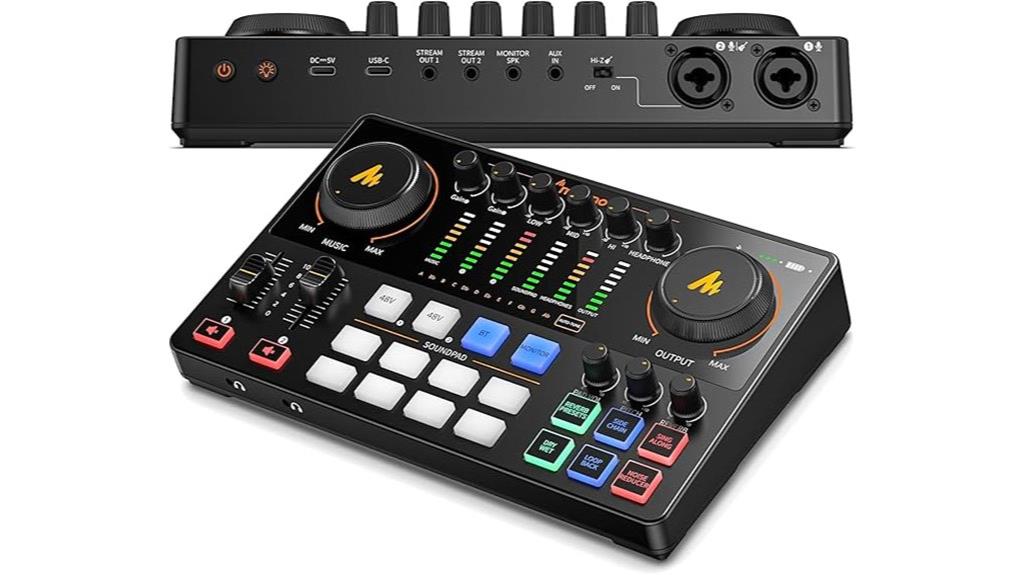
Podcasters looking for a professional-grade audio solution will find the MAONO Podcast Equipment Bundle an ideal choice, thanks to its dual XLR combo inputs with high-quality preamps that eliminate the need for external gear. The MaonoCaster E2 Gen2 offers an intuitive design perfect for podcasting, streaming, and studio work. It delivers crystal-clear sound with low-noise preamps and noise reduction technology, ensuring clean audio even with dynamic mics. Plus, it features customizable sound effects, monitoring options, and versatile connectivity—USB-C, Bluetooth, AUX—in a compact package. The included accessories and broad device compatibility make it a versatile, all-in-one tool for modern content creators.
Best For: podcasters, streamers, and content creators seeking a professional all-in-one audio solution with versatile connectivity and high-quality sound.
Pros:
- High-quality dual XLR combo inputs with 60dB gain eliminate the need for external preamps.
- Crystal-clear sound with low-noise preamps and noise reduction technology ensures professional audio quality.
- Multiple connectivity options including USB-C, Bluetooth, and AUX provide flexible setup for various devices.
Cons:
- The compact design may limit extensive physical control options for advanced users.
- Battery life of up to 8 hours might be insufficient for very long recording sessions without external power.
- Some users may require additional training or familiarity to fully utilize all features and effects.
Depusheng RED USB Audio Interface for Music Recording

Looking for a versatile audio interface that delivers professional sound quality and seamless connectivity? The Depusheng RED USB Audio Interface is an excellent choice. It offers 24-bit/192 kHz studio-grade sound, ensuring crystal-clear recordings. With two combo XLR/Line inputs, it supports microphones, guitars, and bass, plus a HI-Z switch for high-impedance instruments. It features balanced TRS outputs and a stereo headphone jack with independent control. Designed for real-time, delay-free monitoring, it’s perfect for capturing vocals and instruments accurately. Powered via USB 3.0, it works with PC and iOS devices, and its compact, durable build makes it ideal for recording anywhere.
Best For: musicians, producers, and podcasters seeking portable, high-quality audio recording with professional sound clarity.
Pros:
- Provides studio-grade 24-bit/192 kHz sound quality for clear recordings
- Supports multiple instruments and microphones with versatile combo inputs and HI-Z switch
- Compact and durable design ideal for recording on the go in various environments
Cons:
- Limited to USB power, which may require external power sources in some setups
- May require additional equipment for extensive multi-instrument recording needs
- No built-in effects or processing features, requiring external software for editing
PreSonus AudioBox 96 USB Audio Interface

The PreSonus AudioBox 96 USB Audio Interface stands out as a perfect choice for beginners and mobile podcasters seeking high-quality sound in a compact package. Its two Class-A mic preamps deliver clear, professional audio, while the high-headroom instrument inputs easily accommodate guitars, basses, and line-level devices. Supporting up to 24-bit/96 kHz recording, it guarantees studio-grade sound quality. The included Studio One Artist, Ableton Live Lite, and plugins add value for beginners. Its zero-latency monitoring and portable, bus-powered design make it ideal for recording on the go, combining flexibility with impressive audio capabilities.
Best For: beginners, mobile podcasters, and home recording enthusiasts seeking high-quality audio in a portable, easy-to-use interface.
Pros:
- High-quality Class-A mic preamps deliver clear, professional sound.
- Supports up to 24-bit/96 kHz recording for studio-grade audio.
- Comes with valuable recording software like Studio One Artist and Ableton Live Lite.
Cons:
- Limited to 2 input channels, which may restrict larger recording setups.
- No built-in DSP or advanced monitoring features.
- Requires USB bus power, which may be limiting in certain mobile setups.
2×2 USB Audio Interface with Phantom Power and High-Fidelity
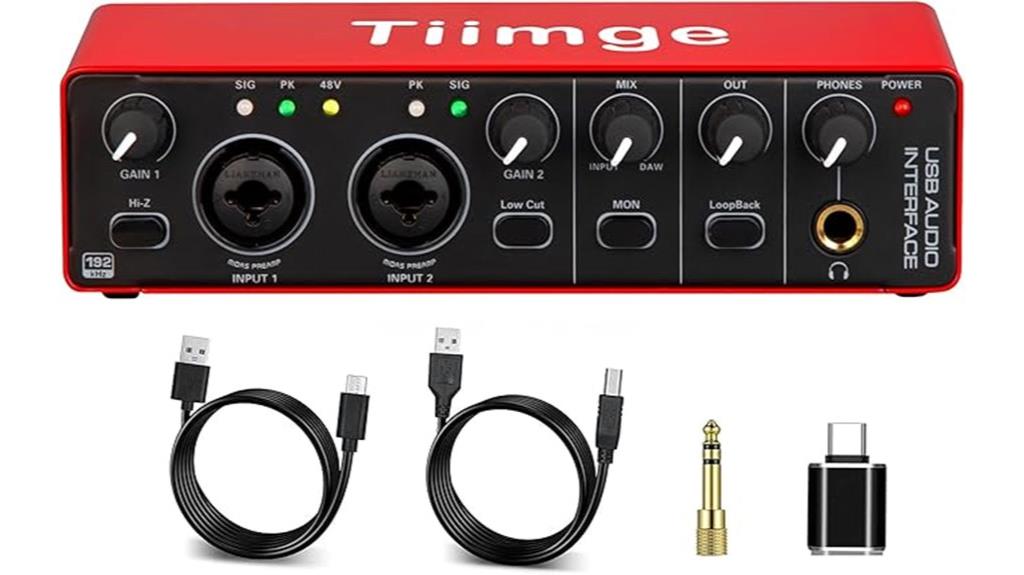
If you’re aiming for professional-quality sound without a complicated setup, the x2 USB Audio Interface with Phantom Power and High-Fidelity is an excellent choice. It offers 24Bit/192kHz high-resolution recording, capturing every detail of vocals, guitars, or instruments. Equipped with 48V phantom power, it powers condenser mics effortlessly. Its plug-and-play design works seamlessly with Windows and Mac OS, supporting popular software like Pro Tools, Ableton, and Cubase. With two combo input jacks and main outputs for monitors or speakers, it’s versatile for recording, live sound, or studio work. Its user-friendly setup makes it perfect for podcasters seeking professional results with minimal hassle.
Best For: musicians, podcasters, and home studio enthusiasts seeking high-quality, easy-to-use audio recording with versatile connectivity.
Pros:
- High-resolution 24Bit/192kHz recording ensures professional sound quality
- Plug-and-play compatibility with Windows and Mac OS simplifies setup
- Versatile input/output options support microphones, instruments, and monitors
Cons:
- Limited to 2 input channels, which may not suit larger recording setups
- No built-in effects or processing features
- Requires external software for advanced editing or mixing
RHM Podcast Equipment Bundle (M9 Set)

The RHM Podcast Equipment Bundle (M9 Set) stands out as the perfect all-in-one solution for content creators who want professional-grade audio without hassle. It combines an audio interface, DJ mixer, microphone, stand, and sound card into a compact, user-friendly package that’s plug-and-play with PCs, smartphones, and cameras. With a built-in battery offering up to 8 hours of use, it’s ideal for live streaming, podcasting, or gaming. The bundle supports multiple microphones and devices simultaneously, with intuitive controls for sound effects, voice changes, and noise reduction—delivering crisp, rich sound quality every time.
Best For: content creators and streamers seeking an all-in-one, portable, professional-grade audio solution for podcasting, live streaming, gaming, or radio broadcasting.
Pros:
- User-friendly, plug-and-play setup compatible with multiple devices including PC, smartphones, and cameras.
- Built-in rechargeable battery provides up to 8 hours of continuous use, ideal for on-the-go recording and streaming.
- Supports multiple microphones and devices simultaneously with extensive sound effects and voice-changing features for dynamic content creation.
Cons:
- May be limited for highly advanced audio engineering needs or large-scale professional studios.
- The compact design might restrict the number of physical inputs compared to larger, dedicated audio interfaces.
- Some users might require additional training or familiarity with sound effects and controls for optimal use.
KA8 8-Channel Mixer Audio Interface with USB, Bluetooth, MP3, and Phantom Power
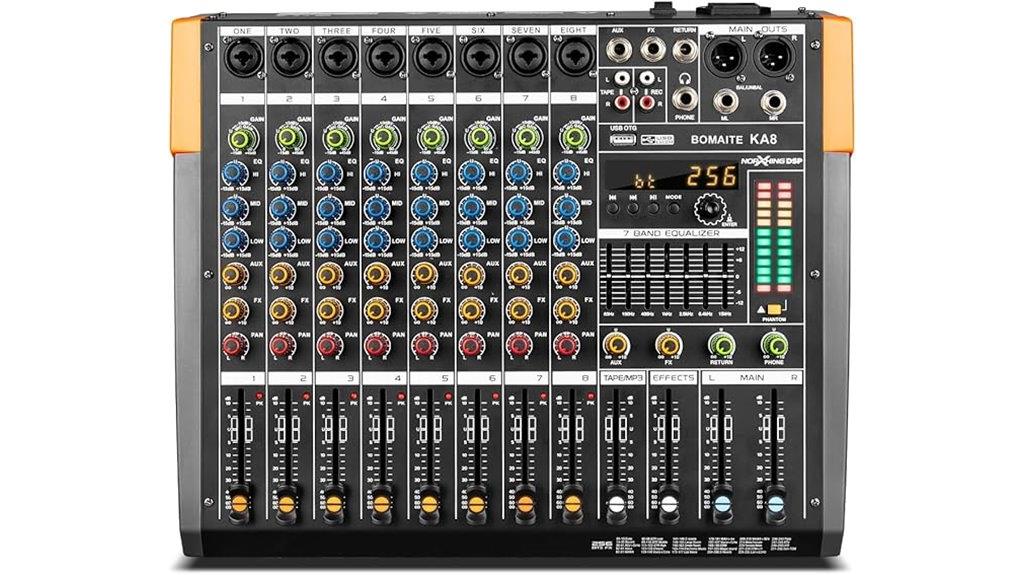
For podcasters seeking a versatile and professional-grade audio interface, the KA8 8-Channel Mixer stands out with its extensive connectivity options and user-friendly controls. It supports USB, Bluetooth, MP3, and flash drives, allowing you to connect multiple devices simultaneously and stream music wirelessly from smartphones or streaming services like Spotify. Its high-quality sound guarantees crystal-clear audio for live recordings, interviews, or performances. With MIC and line inputs, phantom power, and an easy-to-read LCD screen, it simplifies control and monitoring. Compact yet powerful, this mixer is perfect for podcasting, live events, or studio use, delivering professional sound with effortless operation.
Best For: podcasters, live performers, and small studio users seeking a versatile, professional-grade audio interface with multiple connectivity options and easy operation.
Pros:
- Supports multiple device connections via USB, Bluetooth, MP3, and flash drives for flexible audio sources
- Provides crystal-clear, studio-quality sound with professional features like phantom power and accurate LED level monitoring
- Compact, user-friendly interface with built-in controls and an easy-to-read LCD screen simplifies operation for both amateurs and professionals
Cons:
- May have a learning curve for users unfamiliar with audio mixing equipment
- Limited onboard effects or advanced sound processing features
- Slightly heavier or bulkier than basic portable interfaces, which could impact portability
MAONO XLR Podcast Microphone, Cardioid Studio Dynamic Mic

The MAONO PD100 XLR microphone stands out as an excellent choice for content creators who need a durable, studio-grade dynamic mic that delivers clear, natural sound. Its cardioid pattern effectively isolates voice, reducing background noise and ambient interference. Built with a sturdy metal body and vibration-dampening features, it’s both portable and reliable. The mic offers broadcast-quality audio with a wide frequency response, emphasizing voice depth and smoothness with minimal EQ needed. Compatibility with professional audio interfaces via XLR makes setup straightforward. Overall, it’s a versatile, budget-friendly option perfect for podcasting, streaming, and voiceovers, providing professional sound in any environment.
Best For: content creators, podcasters, and streamers seeking a durable, professional-quality microphone with clear sound and easy setup.
Pros:
- Delivers broadcast-quality, natural sound with minimal EQ adjustments needed.
- Robust metal construction and vibration-dampening features ensure durability and stability.
- Compatible with most professional audio interfaces via XLR, making it versatile and easy to integrate.
Cons:
- Can be somewhat quiet, requiring gain boosts for louder recordings.
- Limited frequency response range (60Hz to 14kHz) may restrict certain audio nuances.
- Slightly heavier and larger compared to some compact microphones, which may affect portability in tight spaces.
PYLE Studio Audio Sound Mixer Board (PMXU68BT)
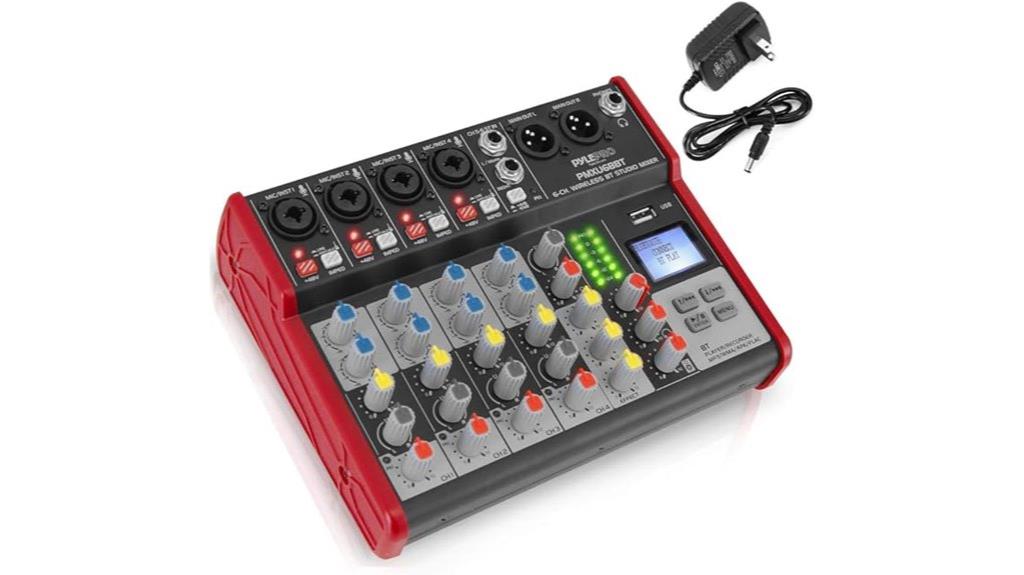
If you’re looking for a versatile mixer that simplifies podcast production, the PYLE PMXU68BT stands out with its built-in Bluetooth streaming and USB audio interface. It offers six channels, including XLR and 1/4″ inputs for mics, instruments, and line sources, plus a headphone jack. The Bluetooth 2.1 feature lets you wirelessly stream audio from smartphones or tablets within 33 feet. Its LCD display shows song info, and phantom power supports condenser mics. While it’s praised for sound quality and ease of use, some users report durability issues with the display and limited USB recording capabilities. Overall, it’s a solid choice for casual and semi-professional podcast setups.
Best For: casual to semi-professional podcasters, DJs, and home audio enthusiasts seeking an affordable, versatile mixer with Bluetooth streaming and basic recording features.
Pros:
- Easy to use with multiple input options including XLR and 1/4″ jacks.
- Built-in Bluetooth 2.1 for wireless streaming from smartphones and tablets.
- Supports a variety of digital audio files and has a user-friendly LCD display.
Cons:
- Limited USB recording capabilities, primarily one-way playback, not suitable for full PC integration.
- Some users experience durability issues with the LCD display after several months.
- Warranty support is limited, often requiring users to pay for repairs out of pocket.
BOMGE Mini 2-Channel USB Audio Interface for Recording and Streaming
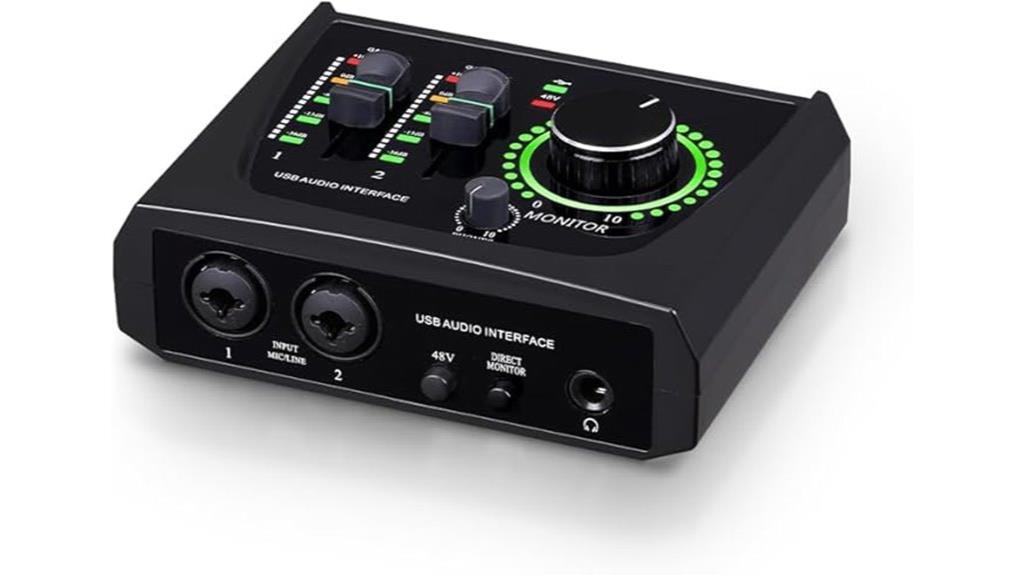
When you’re starting out with podcasting or streaming on a budget, the BOMGE Mini 2-Channel USB Audio Interface stands out as a top choice due to its simplicity and plug-and-play functionality. It works seamlessly with Mac, PC, and iPhone, supporting popular software like GarageBand and Ableton without needing drivers. Its small, portable design makes it perfect for on-the-go recording. Equipped with combo XLR/Line inputs, phantom power, and stereo outputs, it handles microphones and monitors well. Although some users report minor noise or connection issues, overall, it offers decent sound quality and ease of use for beginners and semi-pros alike.
Best For: beginners and semi-professionals seeking an affordable, portable audio interface for podcasting, streaming, and simple music recording.
Pros:
- Easy to set up with plug-and-play compatibility on Mac, PC, and iPhone
- Compact, lightweight design ideal for on-the-go use
- Supports condenser microphones with +48V phantom power and delivers decent sound quality for its price
Cons:
- Reports of minor noise and occasional connectivity issues
- Build quality may feel lightweight and less durable over time
- May experience power issues with certain USB cables or setups
Factors to Consider When Choosing Audio Interfaces for Podcasters

When choosing an audio interface for podcasting, I consider several key factors to guarantee it meets my needs. Compatibility with my devices, quality of microphone preamps, and sound standards are top priorities, along with how easy it is to set up and connect the necessary ports. Understanding these points helps me find an interface that delivers reliable, high-quality audio without hassle.
Compatibility With Devices
Choosing an audio interface that matches your devices is essential for a smooth podcasting setup. You need to check if it supports your connection type, like USB-C, USB-A, or Thunderbolt, to guarantee easy connectivity. Compatibility with your operating system—whether Windows, macOS, iOS, or Android—is important to prevent driver or software issues. Additionally, see if the interface offers plug-and-play functionality or requires additional drivers, as this impacts setup ease. It’s also important to verify that it works seamlessly with your preferred recording or streaming software, such as OBS or GarageBand. If you plan to connect multiple sources like smartphones, tablets, and computers, look for interfaces that support multi-device connections. This way, you’ll avoid compatibility headaches and focus on creating great content.
Microphone Preamps Quality
The quality of microphone preamps in an audio interface directly impacts your podcast’s sound clarity and professionalism. High-quality preamps deliver clean gain with low noise, ensuring your voice sounds clear without hiss or hum. They should have a wide gain range to amplify quiet microphones without causing distortion or clipping. A high signal-to-noise ratio (SNR) helps preserve audio fidelity, especially at higher gain levels, so your recordings stay crisp and natural. Features like phantom power and variable impedance can improve compatibility and sound quality for different microphones. Well-designed preamps produce transparent, natural sound, reducing the need for extensive post-processing. Investing in a good preamp guarantees your recordings sound professional straight out of the box, elevating your podcast’s overall quality.
Ease of Setup
Ease of setup is a crucial factor because it determines how quickly and smoothly you can start recording your podcast. A user-friendly interface typically offers plug-and-play functionality, meaning you can connect and start using it with minimal driver installation or technical hassle. Clear, labeled controls and simple connection options help reduce setup time and avoid confusion. Compatibility with multiple operating systems and devices ensures you don’t waste time troubleshooting or adjusting software. Compact and lightweight designs make it easy to transport and set up in different environments, whether at home or on the go. Additionally, visual indicators like input level lights or clipping alerts provide instant feedback, helping you achieve the correct setup quickly. All these features streamline your workflow and get you recording faster.
Sound Quality Standards
To guarantee your podcast sounds professional and engaging, high sound quality is essential, and several key factors influence this. First, look for interfaces supporting a 24-bit/192kHz sampling rate, which captures detailed, accurate audio. A dynamic range of at least 106dB ensures your recordings can handle a wide spectrum of sound without distortion. Built-in preamps with up to 56dB of gain and low noise are indispensable for clear vocals and instrument capture. Additionally, professional-grade interfaces offer phantom power (48V) to properly power condenser microphones, a staple in podcasting. High-quality analog-to-digital converters are critical, as they preserve the richness and nuances of your sound sources. Prioritizing these standards will markedly elevate your podcast’s audio fidelity and overall professionalism.
Port Selection Options
When selecting an audio interface for podcasting, understanding the available port options is crucial to guarantee compatibility and peak performance. USB is the most common, offering broad compatibility and simple setup, making it perfect for most podcasters. Thunderbolt ports provide faster data transfer and lower latency, ideal for professional recording and editing. USB-C ports are increasingly standard, supporting quick data transfer, power delivery, and portability, which benefits those with mobile setups. Some interfaces feature multiple or combo ports, like XLR, TRS, and USB, offering versatile input and output options for various recording needs. Considering your device compatibility, data transfer requirements, and setup environment helps ensure you choose a port option that aligns with your podcasting goals and workflow.
Software Integration
Choosing an audio interface that seamlessly integrates with your digital audio workstation (DAW) is essential for smooth recording and editing. I look for compatibility to guarantee I can work without technical hiccups. Native driver support for my operating system—whether Windows, macOS, or Linux—is a must, as it reduces latency and improves stability during long sessions. Built-in virtual routing and loopback features are fantastic for live streaming and podcast mixing, as they eliminate the need for extra software. I also verify that the interface supports the sample rates and bit depths I need for high-quality production. Additionally, software control panels or companion apps make configuring and managing my setup quick and intuitive, helping me stay focused on creating great content without hassle.
Budget Considerations
Budget is a key factor when selecting an audio interface for podcasting, as it shapes the features and quality you can access. There are models under $100 that are budget-friendly but often come with limited inputs, lower build quality, and basic sample rates like 48kHz or 96kHz. While these might suffice for casual podcasts, they can impact sound clarity and flexibility. Higher-priced options, costing a few hundred dollars, typically offer better durability, more inputs—including phantom power—and advanced features like low-latency monitoring. Investing a bit more can future-proof your setup, providing improved sound quality and reliability as your podcasting needs evolve. Setting a clear budget helps narrow your options, ensuring you find an interface that balances affordability with essential features for professional-sounding recordings.
Frequently Asked Questions
How Do I Connect Multiple Microphones to a Single Audio Interface?
To connect multiple microphones to a single audio interface, I use an audio mixer or a multi-channel preamp. I connect each mic to separate inputs on the mixer or preamp, then run a stereo output from that device into the interface’s input. This setup allows me to control each mic’s level individually and guarantees clean, balanced sound for my recordings. It’s a simple way to expand your setup efficiently.
What Is the Difference Between USB and Thunderbolt Audio Interfaces?
Imagine you’re recording a podcast and need quick, reliable connections. USB interfaces are typically more affordable, compatible with most computers, and easy to set up. Thunderbolt interfaces offer faster data transfer and lower latency, ideal for high-quality recordings. I recently upgraded to a Thunderbolt interface for my studio, noticing smoother editing and less delay. So, choose USB for simplicity or Thunderbolt if you want top-tier speed and performance.
Can I Use an Audio Interface for Live Streaming and Recording Simultaneously?
Yes, you can use an audio interface for live streaming and recording at the same time. I’ve done it myself, and it works smoothly with the right setup. Just make sure your interface supports multiple outputs and can handle low latency. Using software like OBS or Streamlabs, I connect my interface to my streaming setup, ensuring high-quality sound for both my live audience and recordings without any hassle.
How Important Is Sample Rate and Bit Depth for Podcast Quality?
Sample rate and bit depth are pretty important for podcast quality. Higher sample rates, like 48kHz or 96kHz, capture more detail, making your audio clearer. Bit depth, usually 24-bit, gives you a better dynamic range, reducing noise and distortion. While you don’t need the absolute highest settings, aiming for standard quality guarantees your listeners get a professional sound. I’d recommend prioritizing these settings to elevate your podcast.
Are There Portable Audio Interfaces Suitable for On-The-Go Podcasting?
Yes, there are portable audio interfaces perfect for on-the-go podcasting. I personally recommend models like the Focusrite Scarlett Solo or the Zoom U-48, which are compact, lightweight, and easy to connect anywhere. They offer great sound quality, multiple input options, and USB connectivity. These devices make recording sessions flexible, whether you’re outdoors, traveling, or just moving around, without sacrificing sound quality.
Conclusion
Choosing the right audio interface is like finding the perfect instrument to craft your sound’s symphony. With the options I’ve shared, you’re armed to turn your podcast into a crystal-clear masterpiece that captures attention and elevates your voice. Don’t settle for muffled echoes—think of your sound quality as the brushstroke that paints your podcast’s unique story. Immerse yourself, select your perfect match, and let your voice resonate with clarity and confidence.
